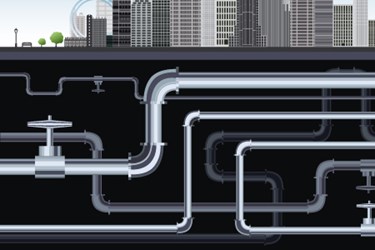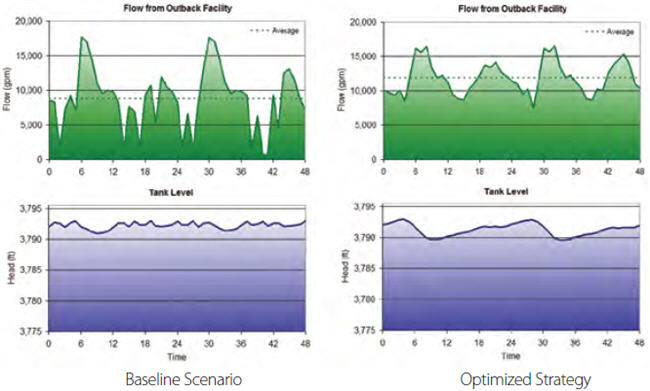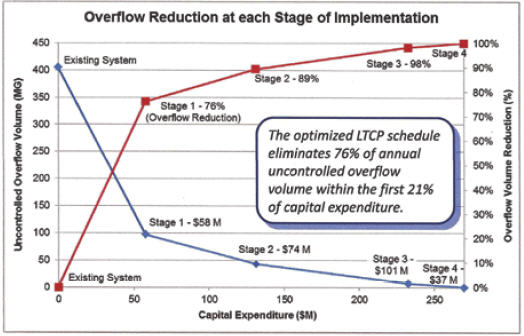Optimized Decision Support For Water, Wastewater, And Stormwater Systems

By Jeffery Frey, PE, co-founder, Optimatics
Innovation is paying dividends for the growing list of municipalities that leverage the latest technology to optimize planning and operations decision making.
Real innovation in the water industry is a goal shared by all stakeholders — municipal and private utilities and their customers; federal and state regulatory agencies, industry organizations, and watchdog groups; equipment manufacturers and software vendors; and consulting engineers. Nancy Stoner, the U.S. EPA’s acting assistant administrator for water, has stated that “technology innovation can accelerate progress toward our goals of clean and safe water. EPA and many stakeholders will strive to support technology innovation to solve water resource problems … cheaper, faster, and using less energy.”
An example of true technological innovation is the development of formal optimization techniques for the planning and operation of water systems based on hydraulic simulation models. Water systems include water distribution, wastewater collection, stormwater, reclaimed water, irrigation, and even water supply and river basin systems. The simulation models include water distribution models, such as EPANET, collection system models, such as EPA SWMM, or water resources/supply models, such as REALM. This article provides an overview of this exciting technological innovation and its benefits, supported by a number of recent case studies highlighting organizations that achieved substantial results using optimized decision support (ODS) software.
Optimization And Optimized Decision Support
Everyone likes to believe they “optimize” their project-planning and system operations. Typically, their process is to identify and evaluate a number of options and then select what appears to be the best capital improvement or operating plan that theoretically meets the design and performance criteria. This is accomplished with an up-to-date hydraulic simulation model using trial-and-error and engineering judgment. This approach, however, is not the type of optimization that qualifies as technological innovation.
True technological innovation requires the use of a powerful, computationally intelligent optimization tool capable of solving both broad questions and the intricacies of complex problems. Water system problems are often highly complex with a seemingly limitless number of options to consider. These problems challenge even the smartest engineers with decades of experience using detailed simulation models. Experience and engineering judgment are invaluable in the search for the best solutions, but far better and faster results can be achieved if an engineer applies the proper optimization tool.
Software can support ODS by enabling engineers and managers to evaluate the full range of alternatives in developing cost-effective, near-optimal solutions for capital planning, operations, and long-term control plans. Software-supported ODS represents a significant advance beyond current practice by helping modelers interact far more intelligently with their simulation models as they vet numerous promising solutions for consideration by utility decision makers.
Benefits Of ODS Approach
Today, the ODS approach is becoming a recognized best practice in the water industry, with utility and consultant managers and modelers studying the appoach and being trained to utilize the software tools. The benefits and value in moving from a simulation-only approach to an ODS approach are impressive. This is evidenced by the level of cost-avoidance achieved on several projects that utilized an ODS approach (see Table 1).
Table 1. Comparison of original simulation solution vs. ODS solution

Capital improvement and lifetime O&M (operations & maintenance) cost savings are drivers for adoption of the ODS approach, particularly due to limited budgets and tighter regulations. Being able to stretch utility dollars to cover more needs and minimize rate increases can help utility managers become more efficient and effective.
Besides reductions in cost, the ODS approach offers other benefits:
- Protecting public health through the reduction of combined sewer overflows (CSOs) and sanitary sewer overflows (SSOs)
- Improving system reliability and sustainability by optimizing for specific emergency scenarios
- Improving hydraulic performance in terms of meeting design criteria
- Gaining confidence in plans developed using a comprehensive, unbiased, defensible approach
- Enabling planners to identify the critical decision choices through more powerful modeling
- Reoptimizing solutions under alternative scenarios and performing unlimited sensitivity analyses
- Finding solutions that balance capital vs. operating costs or gray vs. green infrastructure
- Staging to identify near-term projects that provide maximum value
- Utilizing multiobjective optimization to develop trade-off curves for triple-bottom-line (TBL) objectives
A ‘Glass Box’ Approach
Innovative technologies are often misunderstood. By definition, they differ from the current approach to problem-solving. While the ODS approach has sometimes been called a “black box” approach, this is far from accurate. If anything, the ODS could be called a “glass box” approach.
The ODS approach is transparent. It utilizes existing system simulation models, which in most cases are well understood and accepted by utility planners and managers. The ODS software instructs the system simulation model to create and evaluate many thousands of trial solutions. Trial solutions are automatically created using the range of alternative improvements it is allowed to consider, while the cost and performance of each trial solution (from a full simulation model run) are simultaneously evaluated based on the agreed unit costs and performance critieria.
The inputs into the optimization model are straightforward. Whether for a single neighborhood or a citywide master plan, there are four basic types of input required for any optimization problem:
- An up-to-date, calibrated system simulation model
- Range of allowable decision options to be considered such as new pipe, storage, pump, regulator and plant locations and sizes, green infrastructure and inflow/infiltration removal options, and operating set points
- Corresponding unit costs for the decision options, including energy and O&M costs
- List of design and performance criteria or service levels to be met, such as minimum pressures, maximum velocities, minimum drawdown for tanks to exercise, and overflow and surcharge levels
The results from an optimization run are output as the optimized plan or design that can be saved separately as a simulation model. With the ODS approach, the designs can also be modified manually, which permits the modeler to make changes based on engineering judgment and then quickly run a simulation to check and report out both cost and performance on any number of designs. The knowledge of the engineer and planner are amplified in an ODS approach, enabling a broader range of their choices to be evaluated and allowing for extensive sensitivity analyses.
Sample ODS Case Studies
Several case studies illustrate how the ODS approach is being used by both small and large municipal utilities across the U.S. Bend, OR, optimized its Water System Master Plan in 2009-10. Based on that project’s success, the city required an ODS approach be used by the consultant team to optimize its Comprehensive Sewer Master Plan in 2013-14. South Bend, IN, utilized an ODS approach in the development of its CSO Long Term Control Plan (LTCP) in 2011-12. In 2014, the Los Angeles Bureau of Sanitation and a large Texas city stormwater management group each completed demonstration studies on limited areas of their systems to better learn about the ODS approach and its ability to inform their decision-making process. The following brief descriptions highlight key aspects of these optimization projects, all of which were completed utilizing Optimatics’ Optimizer ODS software tools.
Bend, OR, Operations Optimization. As part of its overall Water Master Plan, the city requested an optimization of existing system operations aimed at reducing pumping energy costs in summer and improving reservoir storage turnover in winter to enhance system water quality. Annual pumping energy costs totaled approximately $700,000, with the majority of the cost coming from pumping groundwater to supplement the lower cost surface water supply in summer.
The first step was to select typical summer and winter periods simulating the historical operation in the model and performing energy usage and cost calculations as a baseline. The ODS software was then formulated to investigate various operating options, including pump trigger levels and pressure-reducing valve (PRV) settings that might reduce costs. The optimization identified revised operating strategies that led to a 23 percent reduction in energy usage for the summer period. The operating changes included restricting flow into key reservoirs during periods of high demand to reduce peak flows in transmission lines, adjusting PRV settings to increase flow transfers from the surface water supply, and boosting surface water between zones rather than pumping groundwater at higher heads — all changes that were discussed and endorsed by the operations group.
In addition to reducing energy usage, the charts in Figure 1 illustrate how restricting flow from the Outback surface water source to the Awbrey Reservoir and forcing the level to vary over a wider range minimizes peak flows from the surface water facility and increases the overall average utilization of the lower-cost surface water.
Figure 1. Improved reservoir exercising and more constant surface water supply

South Bend, IN, CSO LTCP Optimization. South Bend’s consent decree negotiations with the U.S. EPA and the Department of Justice concluded in December 2011. Prior to that, the city requested that its existing CSO LTCP be optimized using the ODS approach to see if any changes were warranted. The project involved updating costs and confirming the LTCP met the four-overflows-per-year level-of-service requirement. In addition, the city wanted to know if some combination of green infrastructure or low-impact development (LID) technologies could supplement or replace proposed LTCP gray infrastructure improvements in order to reduce costs and improve performance.
Table 2 compares the existing CSO LTCP solution (column 2) with an optimized gray-only solution (column 3), the overall optimized gray-green solution (column 4), and a modified optimized solution with the effectiveness of the green infrastructure reduced by 50 percent (column 5). This type of comparison is invaluable to utility decision makers and other stakeholders involved in deciding how the city should proceed. The potential $112 million (27 percent) cost reduction certainly received favorable attention from the Board of Public Works and the mayor, who would be called on to defend the recommended LTCP plans.
In addition to cost savings or cost avoidance, the optimized solution also demonstrated improved hydraulic performance relative to the previous LTCP. The hydraulic performance improvements included 32 percent greater CSO volume eliminated, reduced frequency of CSOs at three locations, and reduced surcharge levels resulting in fewer basement backup issues.
A separate ODS analysis was also performed to optimize staging of the 18 capital improvement projects in the plan. Figure 2 shows how the first five-year stage of the LTCP can achieve an overall reduction in uncontrolled overflows of 76 percent with the expenditure of just 21 percent of the total $270 million capital cost of the optimized LTCP.
Table 2. Baseline CSO LTCP solution vs. optimized solution and two other scenarios

Los Angeles Bureau of Sanitation Optimization. LA BOS identified a small, but challenging problem facing their planning team. They desired to identify the best solution to augment reclaimed water supplies to one of their service areas during dry weather periods. A variety of options were identified, including construction of a dedicated pipeline between two existing plants and construction of new pipelines along allowable routes to provide additional capacity within the service area. The options were formulated in the ODS software program with new pipe and pump station upgrade costs and service level criteria. The study demonstrated to LA BOS managers and engineers the ease of the optimization formulation and its ability to quickly develop and compare near-optimal solutions that may not have been identified using the normal trial-and-error method. The estimated cost of the optimized alternatives was just 50 percent of the original dedicated pipeline plan cost.
Figure 2. Optimized staging achieves maximum overflow reduction in near term.

Stormwater Optimization. The benefits of utilizing ODS for stormwater optimization have been demonstrated through finding optimal solutions on combined sewer systems which are dominated by stormwater runoff. Recently, a more pointed approach to optimization was adopted on a stormwater collection system in Texas. ODS was used to select improvement options that would eliminate flooding under the 100-yearstorm design, for a portion of its stormwater network. The city provided an EPA SWMM model for an area covering 29 subcatchments. The optimization was formulated to consider 87 new pipe and 6 storage options as well as green infrastructure options to reduce surface runoff in each of the subcatchments. The project demonstrated how ODS could be utilized for stormwater applications to mitigate flooding at least cost.
ODS: A True Technological Innovation
A powerful technological innovation is changing the way utility managers and engineers approach capital planning and operations of water systems. The ODS approach is founded upon advanced computationally intelligent software tools developed, tested, and proven over the past 19 years with leading utilities in the U.S., Canada, Australia, New Zealand, the U.K., and China. As ODS is utilized by more utility and consultant planners and modelers, the ability to identify low-cost, near-optimal solutions will benefit stakeholders while providing a return on investment.

About The Author
Jeffery Frey, PE, co-founded Optimatics in 1996, after 15 years at Harza Engineering Company.
